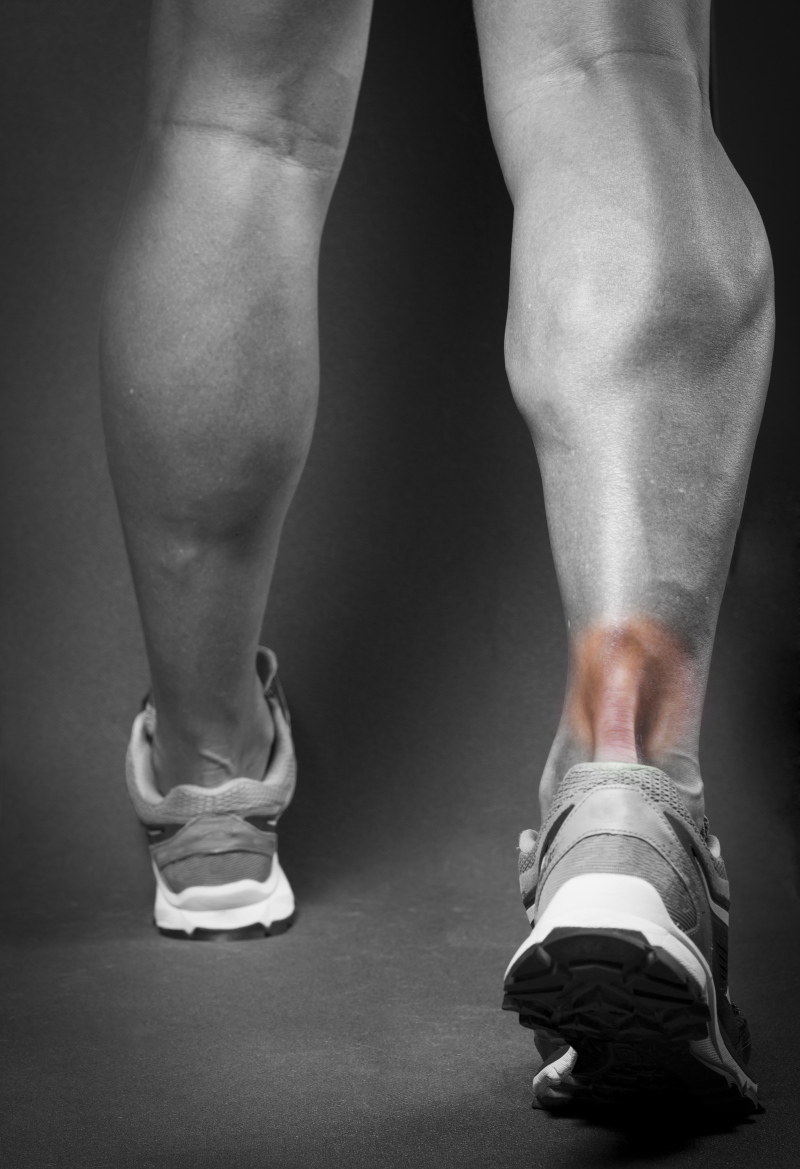Named after the famous Greek Warrior God the Achilles tendon is the largest and strongest tendon in the human body. It is approximately 15cm in length and rotates clockwise up to 90 degrees, running from the soleus and gastrocnemius muscles and inserting into the back of the heel. The tendon is surrounded by a paratenon allowing it to glide back and forth. It is made up of Type I collagen giving it the ability store and release energy so that it can stretch and recoil like a spring in response to the stretch/shortening cycle of the gastrocnemius and soleus muscles – an important action for locomotion.
This unique structure allows the Achilles to withstand fast and dynamic loads, which can be up to 7 x a persons body weight during running and jumping activities (1). It also makes rehabilitation of this tendon very challenging.
It is the most commonly injured tendon in the human body and complete ruptures are reported from 11 to 37 per 100,000 population and are currently on the increase (1).
A ruptured tendon is when there is a complete full thickness tear through the tendon fibres.
An Achilles rupture will often be a traumatic injury with acute pain and a sudden inability to walk. Patients describe a popping sensation at their heel and a feeling of being kicked.
For the Achilles this injury has a bimodal age distribution with it occurring in 2 groups of the population – those between 25-40yrs and those over 60 yrs (2). It is generally an acute injury in the younger group and can be more of a chronic presentation in the older population – although as our aging population strive to remain active we are seeing an increasing number of acute ruptures in this older demographic.
This bimodal age distribution is significant when it comes to deciding on the best management with rehabilitation being governed by the age and health of the tendon. As a physiotherapist rehabilitating an Achilles rupture – both when surgically or non-surgically managed - my rehabilitation program and my expected outcomes would be different for a 25 year old compared to a 65 year old.
Unsurprisingly a rupture to this tendon is a debilitating injury and rehabilitation is on par with an ACL reconstruction of the knee.
Management of these injuries have always been somewhat controversial with surgical management being the traditional choice due to the high re-rupture rates and the risks of tendon lengthening in conservatively managed patients (3). However the risk of complications with surgery – including nerve damage, wound infection and scar adhesions - have lead to the pursuit of improved non-surgical management.
Over the last 20 years there has been a development of stricter rehabilitation protocols aimed at restoring tendon function. In particular the introduction of early weight bearing - this has been shown to promote the synthesis of type I collagen which is vital in restoring the tendons load resistant properties mentioned earlier (4). When these developments, which have also included functional orthosis and graded angles of plantar flexion, are introduced into non-surgical management protocols they have lead to a reduction in the non-surgical re-rupture rates and an improvement in long term function resulting in higher a return to work and to recreational activities (5,6).
We are now in a position where non operative management can be recommended for a large proportion of Achilles ruptures knowing that the outcomes will be similar to surgical repairs without the risks of surgery - as long as rehabilitation protocols are followed (7,8).
The development of rehabilitation protocols have assisted both surgically and non-surgically managed Achilles ruptures. These protocols are aimed at stimulating tendon healing and restoring the mechanical properties through a graded program of exercises and activities. These programs will differ from one patient to the next due to age, general health and patient goals – it is therefore beneficial to have an experienced clinician monitoring and progressing these protocols.
Although an Achilles rupture is still a serious injury, which requires a long period of rehabilitation, whether treated surgically or non-surgically, the development of rehabilitation protocols over the last 20 years has meant we are now able to restore the tendon back to withstanding fast and dynamic loads meaning more people are returning to their work and recreational activities.
- Jarvinen T A H et al. Achilles tendon disorders: Etiology and epidemiology. Foot Ankle Clin. 2005
- Moller A et al. Increasing incidence of Achilles tendon rupture. Act Orthop Scand. 1996
- Waterston S, Maffulli N, Ewen W. Subcutaneous rupture of the Achilles tendon: basic science and some aspects of clinical practice. Be J Sports Med 1997; 31:285-298
- Valkering KP et al. Functional weight-bearing mobilization after Achilles tendon rupture enhances early healing response: a single blinded randomized controlled trial. Knee Surg Traumatol Arthosc. 2017.
- Soroceanu A, Sidhwa F, Aarabi S, et al. Surgical versus nonsurgical treatment of acute achilles tendon rupture. J Bone Joint Surg Am 2012;94:2136–43.
- Winson D, MacNair R, Hutchinson A, Owen N, Evans R, Williams P. Delayed Achilles tendon rupture presentation: Non-opertaive management may be the SMART choice. The Foot 2020.101724
- Willits K, Amendola A, Bryant D, et al. Operative versus nonoperative treatment of acute Achilles tendon ruptures: a multicenter randomized trial using accelerated functional rehabilitation. J Bone Joint Surg Am 2010;92:2767–75.
- Wallace R, Heyes G, Michael A. The non-operative functional management of patients with a rupture of the tendo Achillis leads to low rates of re-ruputre. J Bone Joint Surg Br 2011;93-B:1362-6

